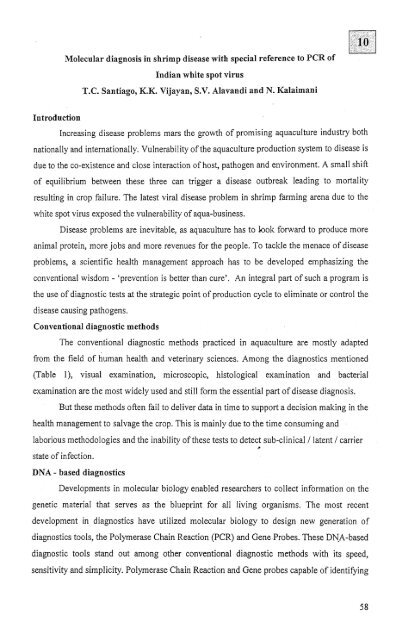, Diagnosis an-&& of Shrimp Diseases - Central Institute of ...
, Diagnosis an-&& of Shrimp Diseases - Central Institute of ...
, Diagnosis an-&& of Shrimp Diseases - Central Institute of ...
- No tags were found...
You also want an ePaper? Increase the reach of your titles
YUMPU automatically turns print PDFs into web optimized ePapers that Google loves.
IntroductionMolecular diagnosis in shrimp disease with special reference to PCR <strong>of</strong>Indi<strong>an</strong> white spot virusT.C. S<strong>an</strong>tiago, K.K. Vijay<strong>an</strong>, S.V. Alav<strong>an</strong>di <strong>an</strong>d N. Kalaim<strong>an</strong>iIncreasing disease problems mars the growth <strong>of</strong> promising aquaculture industry bothnationally <strong>an</strong>d internationally. Vulnerability <strong>of</strong> the aquaculture production system to disease isdue to the co-existence <strong>an</strong>d close interaction <strong>of</strong> host, pathogen <strong>an</strong>d environment. A small shift<strong>of</strong> equilibrium between these three c<strong>an</strong> trigger a disease outbreak leading to mortalityresulting in crop failure. The latest viral disease problem in shrimp farming arena due to thewhite spot virus exposed the vulnerability <strong>of</strong> aqua-business.Disease problems are inevitable, as aquaculture has to look forward to produce more<strong>an</strong>imal protein, more jobs <strong>an</strong>d more revenues for the people. To tackle the menace <strong>of</strong> diseaseproblems, a scientific health m<strong>an</strong>agement approach has to be developed emphasizing theconventional wisdom - 'prevention is better th<strong>an</strong> cure'. An integral part <strong>of</strong> such a program isthe use <strong>of</strong> diagnostic tests at the strategic point <strong>of</strong> production cycle to eliminate or control thedisease causing pathogens.Conventional diagnostic methodsThe conventional diagnostic methods practiced in aquaculture are mostly adaptedfrom the field <strong>of</strong> hum<strong>an</strong> health <strong>an</strong>d veterinary sciences. Among the diagnostics mentioned(Table I),visual examination, microscopic, histological examination <strong>an</strong>d bacterialexamination are the most widely used <strong>an</strong>d still form the essential part <strong>of</strong> disease diagnosis.But these methods <strong>of</strong>ten fail to deliver data in time to support a decision making in thehealth m<strong>an</strong>agement to salvage the crop. This is mainly due to the time consuming <strong>an</strong>dlaborious methodologies <strong>an</strong>d the inability <strong>of</strong> these tests to detect sub-clinical I latent I carrier,state <strong>of</strong> infection.DNA - based diagnosticsDevelopments in molecular biology enabled researchers to collect information on thegenetic material that serves as the blueprint for all living org<strong>an</strong>isms. The most recentdevelopment in diagnostics have utilized molecular biology to design new generation <strong>of</strong>diagnostics tools, the Polymerase Chain Reaction (PCR) <strong>an</strong>d Gene Probes. These DNA-baseddiagnostic tools st<strong>an</strong>d out among other conventional diagnostic methods with its speed,sensitivity <strong>an</strong>d simplicity. Polymerase Chain Reaction <strong>an</strong>d Gene probes capable <strong>of</strong> identifying
















